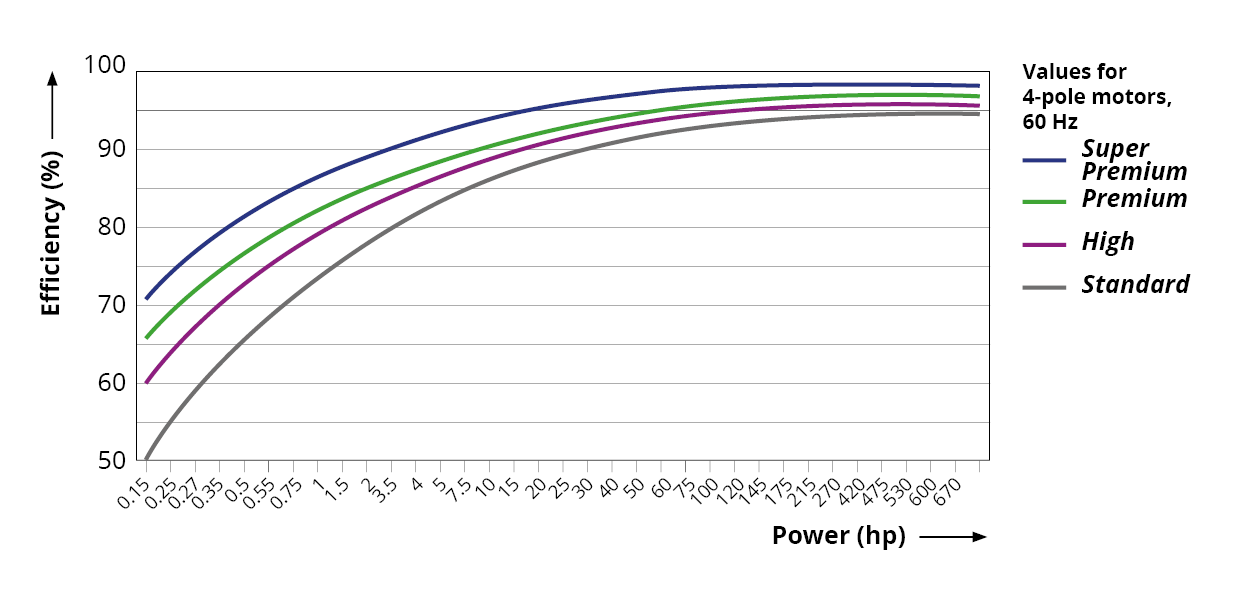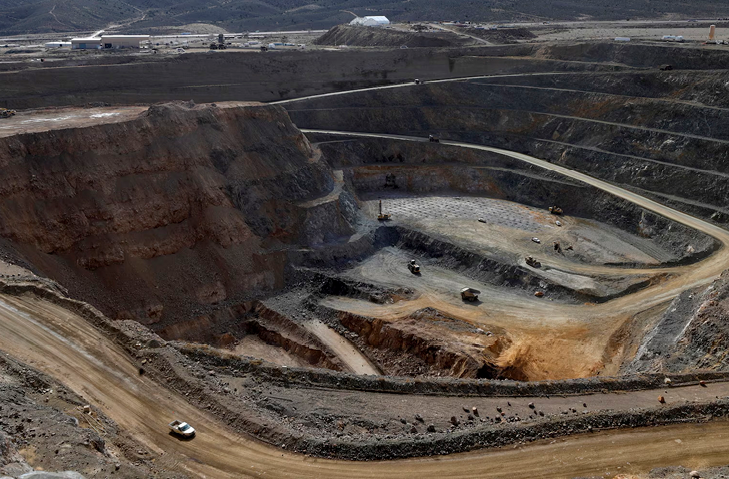AC induction motors turn energy from the mains electricity supply into rotational power by energizing electromagnets to generate a rotating magnetic field within the motor stator, which then imparts a rotational force to the motor rotor and output shaft.
The motor stator (housed within the motor casting) has magnets around its circumference arranged so that the poles of these alternate between positive and negative magnetic polarity when connected to an AC mains electrical supply. As these electromagnets are energized, they repel or attract the magnets mounted on the motor rotor, so that the rotor then spins around within the stator electromagnets, imparting the rotation to the motor shaft and ultimately the fan impeller, which then moves air through the fan housing (casing). The motor speed is determined by the number of magnetic poles. Fewer poles, means that the motor output shaft will spin faster. You can read more in our Motor Basics blogs.
Traditionally, AC induction motors are used to power fans, but EC, or PM motors are increasingly becoming more common.
AC motors use an alternating current (AC) provided from the mains electricity supply grid to energize its electromagnets. In the US the electricity supply voltage alternates between positive and negative values at a frequency of 60 Hz or 60 times per second, which means that the polarity of the electromagnets inside an AC motor reverses 60 times per second. AC motors under a normal load, at full speed, are efficient and economical to manufacture. In addition, as they don’t have any onboard drive control electronics, they can also be used in harsh environments and for emergency smoke extraction, where air temperatures can reach 400°C for a duration of 2 hours.
EC (Electronically Commutated) motors convert alternating current (AC) from the mains supply into direct current (DC). The magnets in this case are not electromagnets but are permanently magnetized (which is where the term 'PM' comes from). To create rotation at the motor output, intelligent built-in electronics constantly monitor the exact location of the motor shaft rotor or external rotor to impart rotation to the output in the desired direction and at the required speed.
Although AC motors can be speed controlled (normally via a Variable Speed Drive, or Frequency Converter), EC motors have their speed control drive electronics built in (normally mounted on the non-drive end of the motor) and so speed control is easy as there is only a need to provide a simple zero-to-10-volt input signal.
Both AC and EC motors can therefore be run at varying speeds (dependent on airflow demand), which means that as the fan speed reduces, the fan power requirement also reduces. As fan power (shaft power) needs vary as a cube of the ratio of full speed versus reduced speed, this means that both AC and EC motors will therefore use less power when run at a lower speed. It is also possible, in many cases, to use AC motors which have identical NEMA rating to EC motors. However, as the efficiency of a typical EC motor tends to be more constant across their whole load characteristic, they can, potentially, save more energy than an equivalent AC motor, which can have a significant drop in efficiency when run below 50% of full speed load. If the EC fan is being operated within the 75% to 100% speed range, or if the fans are being run at a constant 100% load, then there will actually be very little energy consumption difference between a fan fitted with an AC motor and one with an EC motor.
Fans with an AC motor fitted are typically between 70-88% efficient, whilst fans with an EC motor can be around 80-90% efficient. While they cost more to buy, they could (depending on their power rating and operating mode) have a slightly reduced running cost. However, as previously mentioned, EC motors are not suitable for all fan applications. They cannot, for example, handle high temperatures, as the rare earth permanent magnets used in their construction will de-magnetize.
EC motor power outputs are also far more limited than AC motors. Typically, EC motor powers are limited to less than 22kW, whilst AC motors can be built to deliver very high powers, some examples being rated for 1 Megawatt (which would be needed for large infrastructure projects such as rail or road tunnels). Whilst both AC and EC motor manufacture consumes precious raw materials, EC motors must use permanent magnets in order to operate. These are manufactured from rare earth ores, which are naturally harder to find, more expensive to manufacture and can often have a larger carbon footprint than the AC motor alternative. This needs to be considered against the environmental claim that EC motors are better as they use less energy during operation.

If a fan fitted with an AC motor is used with an inexpensive transformer-type fan speed controller, it may produce an unwanted noise due to the way the controller adjusts the power input to the motor. This can largely be 'engineered out' by carefully matching the motor and controller, and by ensuring that only good quality control components are used. 'Drive noise' was definitely an issue for Variable Speed Drives (VSDs) when these were first launched, but technology has come a long way. If a good quality VSD is used, noise is not normally an issue. In fact, in simplistic terms, as EC motor and VSD drive control components are very similar, there is technically not a great deal of difference between them; EC motors have these built in, whilst AC motors don’t. VSDs coupled with fans fitted with AC motors can deliver the same level of speed control as a fan fitted with an EC motor.
It is true that fans with EC motors fitted don’t tend to produce unwanted noise when their speed is turned down, and that they can be turned up from minimum to maximum and every speed in-between, but the same is true for a fan fitted with an AC motor controlled via a VSD.
As EC fan speed controllers are built on the same principles as VSDs, the overall efficiency of the fan/motor/drive system will be very similar when compared with the AC alternative. The EC fan will be more efficient than AC fan if only a basic VSD is used, which will increase the running cost. As the AC option in this case would have a much lower initial capital cost, there is a finely balanced judgement to be made. Our Fan Selector Tool allows you to compare the options available to find the best power to efficiency ratio for your requirements.
In some cases, fans with in-built EC motors are smaller (for a given power rating), than the equivalent fan fitted with an AC motor, but this is largely dependent on the design of the motor. In essence there are two basic concepts: internal rotor and external rotor motor designs. As the latter has the fan impeller built into the external surface of the motor, this will of course optimize and reduce the overall product footprint. However, this also means that there are fewer serviceable parts, so if the impeller is damaged, this normally means that the complete fan must be changed, which goes against the principles of a future proposed circular economy, which requires products to be repairable. Fans which use internal rotor motors (typically AC induction motors with an output shaft on which an impeller can be mounted) can, in contrast, have their impellers changed if required
At first glance, it would appear that EC motors are the way forward, but there are downsides.
The magnets in an EC motor are permanent magnets which are made from special alloys (ferromagnetic materials) such as iron, nickel and cobalt, several alloys of rare-earth metals and minerals such as lodestone. Despite their name, rare-earth metals aren’t actually rare, but tend to be mixed with other materials rather than found in concentrated deposits. This means you need to mine extensively to obtain useable quantities, digging vast open pits in the ground, which can contaminate the environment and disrupt ecosystems. When poorly regulated, mining can produce wastewater ponds filled with acids, heavy metals and radioactive material that might leak into groundwater. Processing the raw ore into a form useful to make magnets and other tech is a lengthy effort that takes large amounts of water and potentially toxic chemicals and produces voluminous waste.



China is currently the world's largest producer of rare earth elements, accounting for 70% of global annual mine production, estimated at 231,000 tons for 2022. The United States, Australia, Burma (Myanmar) and Thailand accounted for the majority of the remaining mine production.
Researchers are investigating everything from reducing the amount of waste produced during the ore processing to improving the efficiency of rare earth element separation, which can also cut down on the amount of toxic waste. Scientists are also testing alternatives to mining, such as recycling rare earths from old electronics or recovering them from coal waste.
The other problem is that permanent magnets, if exposed to high temperatures for any length of time can become weaker, demagnetized, or even permanently damaged:
That said, it is clear that EC motors are becoming increasingly important in the efforts we are making towards sustainability and, when some of the production and longevity issues are resolved, they are likely to become more prevalent.
Most of Woods Air Movement’s fans are still supplied with AC motors but the available range of EC variants is growing as we continue to explore how to make the most of EC technology. Our experienced teams can help you work out which type of fan will provide you with the best cost versus performance ratio for your requirements. Get in touch today to find out more.